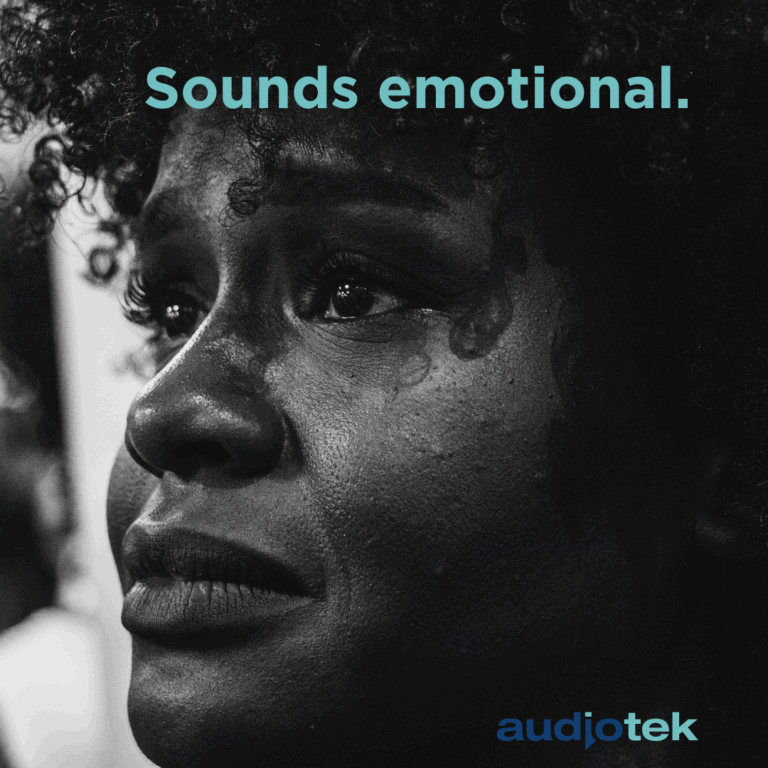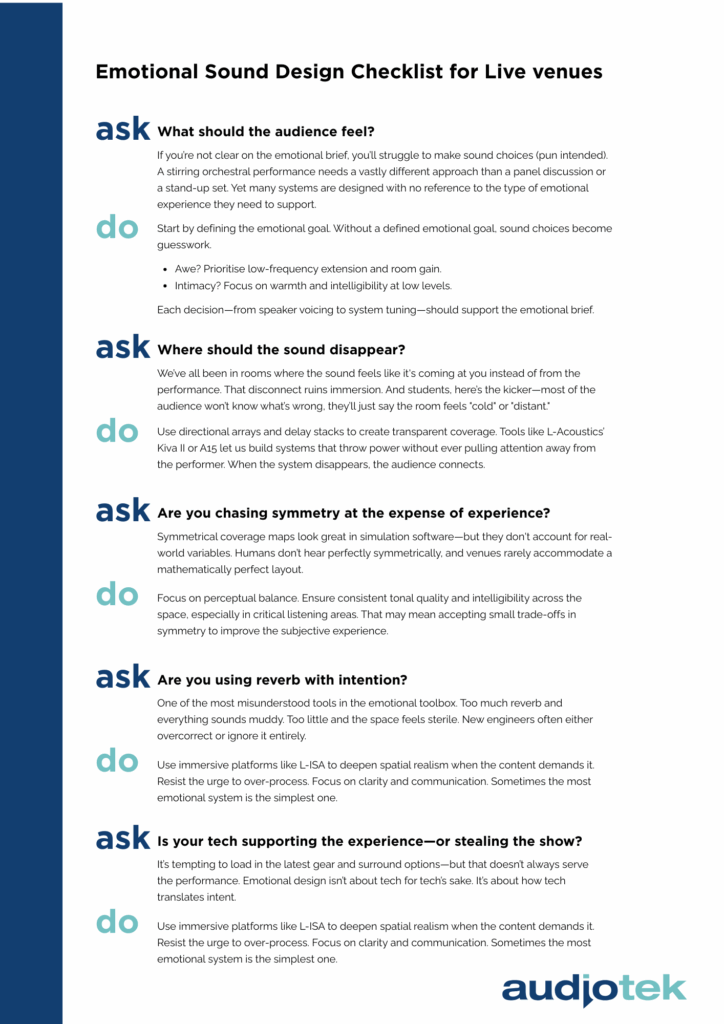Emotional Sound Design: How to Make Concert Halls Sound Incredible By Chris Kmiec BEng MISCVE
Chris Kmiec is a venue acoustics specialist with over 15 years of experience designing sound systems for some of Europe’s most iconic spaces, including theatres, arenas and historic venues.
I remember standing at the back of a newly renovated concert hall, during a final sound check. The system was flawless on paper: perfect coverage, beautiful clarity, and every spec ticked off. But as the pianist began to play, something felt … off. The sound was clean, but it lacked warmth. Precision? Yes. Emotion? No. And that’s when I realised: sound engineering isn’t just about getting it technically right. It’s about making people feel something.
Why technical perfection isn’t enough
It’s easy to get lost in the metrics: RT60, SPL, dispersion maps, and simulation plots. And don’t get me wrong—they matter. But I’ve stood in too many venues that looked great on paper and felt completely lifeless in person.
Humans respond to sound in ways we often can’t explain with data. We feel tension in reverb. We get goosebumps in the right kind of silence. If a venue’s sound doesn’t support that emotional range, it fails—even if it meets every spec in the book.
What is emotional sound design?
In over 15 years of designing systems for venues across Europe, I’ve come to understand that emotional sound design is what separates a venue people remember, from one they forget the moment they walk out.
It’s the art of aligning the auditory experience with the emotional intent of the performance. Not just intelligibility or fidelity—feeling.
Sound can:
- Build anticipation with subtle reflections and soft low frequencies
- Create intimacy through warmth and proximity in spoken word
- Deliver power and catharsis through controlled low-end and spatial clarity in rock and orchestral music
The difference between a sterile mix and a goosebump-inducing one is often in the tiny details: how a reverb tail decays, how frequencies interact in a space, how sound wraps around an audience rather than colliding with them.
Timbre, transient response, spatial placement—these are emotional tools, not just technical specs. When tuned with intention, they evoke connection, memory, and reaction.
This is why we often partner with companies like L-Acoustics, whose approach to discreet yet powerful systems allows us to design for both nuance and impact. Their work at venues like the National Theatre shows how precision can serve storytelling—not just volume.
Designing for emotional impact in live venues.
Designing for emotion means stepping beyond technical checklists and thinking about how the audience experiences sound—moment to moment, row to row. These aren’t abstract ideas; they’re questions I ask every time I walk into a new venue or start a new design brief. And more importantly, they’re the same questions every student or early-career engineer should learn to ask too.
1. Ask: What should the audience feel?
If you’re not clear on the emotional brief, you’ll struggle to make sound choices (pun intended). A stirring orchestral performance needs a vastly different approach than a panel discussion or a stand-up set. Yet many systems are designed with no reference to the type of emotional experience they need to support.
Do: Start by defining the emotional goal. Without a defined emotional goal, sound choices become guesswork.
- Awe? Prioritise low-frequency extension and room gain.
- Intimacy? Focus on warmth and intelligibility at low levels.
Each decision—from speaker voicing to system tuning—should support the emotional brief.
2. Ask: Where should the sound disappear?
We’ve all been in rooms where the sound feels like it’s coming at you instead of from the performance. That disconnect ruins immersion. And students, here’s the kicker—most of the audience won’t know what’s wrong, they’ll just say the room feels “cold” or “distant.”
Do: Use directional arrays and delay stacks to create transparent coverage. Tools like L-Acoustics’ Kiva II or A15 let us build systems that throw power without ever pulling attention away from the performer. When the system disappears, the audience connects.
3. Are you chasing symmetry at the expense of experience?
Symmetrical coverage maps look great in simulation software—but they don’t account for real-world variables. Humans don’t hear perfectly symmetrically, and venues rarely accommodate a mathematically perfect layout.
Do: Focus on perceptual balance. Ensure consistent tonal quality and intelligibility across the space, especially in critical listening areas. That may mean accepting small trade-offs in symmetry to improve the subjective experience
4. Are you using reverb with intention?
One of the most misunderstood tools in the emotional toolbox. Too much reverb and everything sounds muddy. Too little and the space feels sterile. New engineers often either overcorrect or ignore it entirely.
Do: Design reverb to match genre, audience proximity, and architecture. In dry spaces, digital enhancements can add life. In live spaces, absorption and diffusers help sculpt reflection patterns. Above all, treat reverb as an emotional tone control, not a nuisance.
5. Is your tech supporting the experience—or stealing the show?
It’s tempting to load in the latest gear and surround options—but that doesn’t always serve the performance. Emotional design isn’t about tech for tech’s sake. It’s about how tech translates intent.
Do: Use immersive platforms like L-ISA to deepen spatial realism when the content demands it. Resist the urge to over-process. Focus on clarity and communication. Sometimes the most emotional system is the simplest one.
Emotional sound design is about more than gear.
As engineers, we’re not just managing gear—we’re managing moments.
- The sigh of a solo violin.
- The collective breath before a chorus hits.
- The silence that says more than the notes.
That’s the real job.
And it means listening with your ears—not just your software. It means questioning designs that measure well but feel sterile. And it means collaborating with architects, performers, and venue managers early in the process to ensure the emotion comes through
Final thoughts (and a free guide)
If you care about building venues that move people, not just impress them, emotional sound design has to be part of your process.
I’ve written a full open-access guide covering everything from acoustic fundamentals to genre-specific sound strategies.
Download it here for free — no sign-up, no fluff.
Because in the end, it’s not about how loud it is. It’s about how it makes you feel.
Here’s a short, on-brand blurb you can use next to the checklist download:
Free Download: Emotional Sound Design Checklist for Live venues
Looking for a quick-reference guide to help design sound systems that connect—not just project?
Download this practical checklist from Chris Kmiec’s cornerstone article on emotional sound design. Perfect for engineers, students, and venue teams, it outlines the essential questions to ask—and what to do—to create sound that truly resonates.
Frequently Asked Questions
What is emotional sound design in concert halls?
Emotional sound design is the practice of shaping audio systems to evoke specific emotional responses from the audience, aligning sound with the intent of the performance. It goes beyond technical specs to focus on warmth, immersion, and clarity.
Why is emotional sound design important?
Technically perfect systems can still feel lifeless. Emotional sound design ensures audiences feel more than just volume—they experience connection, awe, or intimacy, depending on the event.
How can I design sound for emotional impact?
Start by defining the emotional goal (e.g., awe, closeness), then choose equipment and tuning strategies that support it. Use directional arrays for transparency, reverb intentionally, and avoid tech overload.
What role does reverb play in emotional sound?
Reverb shapes space and mood. Properly tuned, it enhances immersion; poorly controlled, it can muddy sound. It should be designed around venue size, performance type, and architectural acoustics.
Who is Chris Kmiec?
Chris Kmiec BEng MISCVE is a professional sound engineer and venue acoustics designer with over 15 years of experience in live sound, theatre, and performance spaces across Europe.

Chris Kmiec
A self confessed AV nerd, Chris is a graduate of Surrey University and has over 15 years experience with commercial AV design for venues of all types in every corner of the world.


